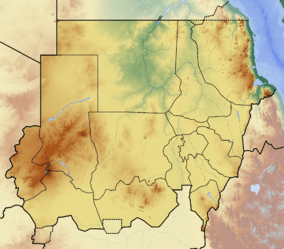Jebel Sahaba
| Jebel Sahaba | |
|---|---|
 Jebel Sahaba (جبلْ سَحَبَ) | |
| Location | Sudan |
| Coordinates | 21°59′N 31°20′E / 21.983°N 31.333°ECoordinates: 21°59′N 31°20′E / 21.983°N 31.333°E |
Jebel Sahaba (also Site 117) is an ancient cemetery discovered in 1964 by a team led by Fred Wendorf near the northern border of Sudan. One skeleton was radiocarbon dated to approximately 13,140-14,340 years old;[1] newer apatite dates indicate that the site is at least 11,600 years old.[2] These dates confirm the association of the site with the Qadan culture, and the site is often cited as the oldest known evidence of warfare.[3]
Discovery
The original project that discovered the cemetery was the UNESCO High Dam Salvage Project.[4] This salvage dig project was a direct response to the raising of the Aswan Dam which stood to destroy or damage many sites along its path.
Three cemeteries are present in this area, two of which are collectively called Jebel Sahaba, one on either side of the Nile. A third cemetery nearby is referred to as Tushka.
Skeletal remains
61 individual skeletons were recovered at Jebel Sahaba, as well as numerous other fragmented remains. Of the men, women, and children buried at Jebel Sahaba, at least 45% percent died of violent wounds.[5] Pointed stone projectiles were found in the bodies of 21 individuals, suggesting that these people had been attacked by spears or arrows. Cut marks were found on the bones of other individuals as well.[5] Some damaged bones had healed, demonstrating a persistent pattern of conflict in this society.[5]
Curation
The bodies and any other artifacts recovered by the UNESCO High Dam Salvage Project were donated by Wendorf to the British Museum in 2002.[6] This collection includes skeletal and fauna remains, lithics, pottery, and environmental samples as well as the full archive of Wendorf's notes, slides, and other material during the dig.
See also
References
- ↑ Dawn of Ancient Warfare. Ancient Military History. Retrieved December 17, 2011.
- ↑ Antoine, Daniel; Zazzo, Antoine; Friedman, Renée (2013). "Revisiting Jebel Sahaba: new apatite radiocarbon dates for one of the Nile valley's earliest cemeteries". American Journal of Physical Anthropology: 68. doi:10.1002/ajpa.22247.
- ↑ Kelly, Raymond (October 2005). "The evolution of lethal intergroup violence". PNAS. 102: 24–29. doi:10.1073/pnas.0505955102. PMC 1266108
 . PMID 16129826.
. PMID 16129826. - ↑ http://whc.unesco.org/uploads/activities/documents/activity-173-2.pdf
- 1 2 3 Friedman, Renée. "Violence and climate change in prehistoric Egypt and Sudan". British Museum blog.
- ↑ http://www.dailymail.co.uk/sciencetech/article-2691102/The-race-war-Scientists-investigating-13-000-year-old-bodies-discovered-edge-Sahara.html
Further reading
- F. Wendorf, 'Site 117: A Nubian Final Paleolithic Graveyard near Jebel Sahaba, Sudan'. In: F. Wendorf, Editor, The Prehistory of Nubia, Southern Methodist University, Dallas (1968), pp. 954–987.